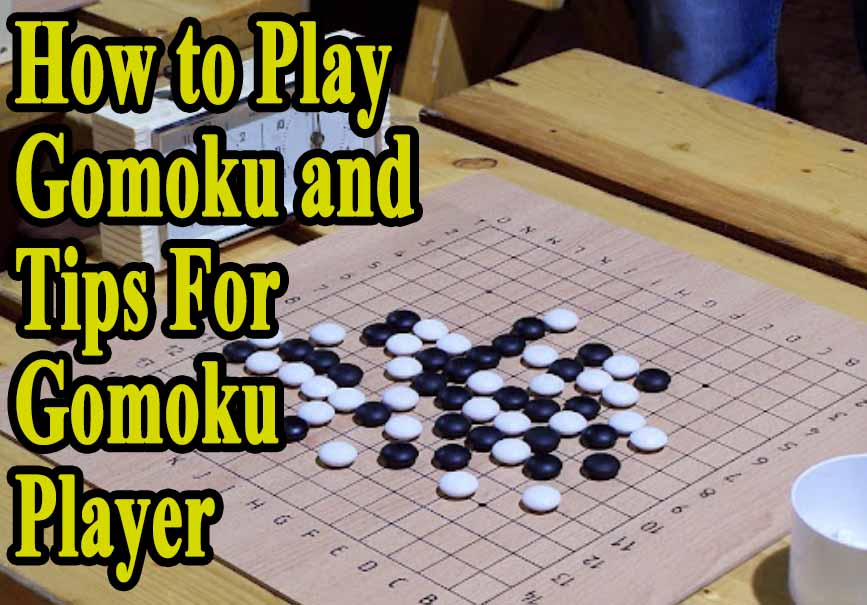Gomoku is a traditional Japanese board game for two players that resembles tic-tac-toe, but has a much more complex set of rules. The objective of the game is to create unbroken lines of 5 pieces in any direction by placing black and white pieces alternately on the board. Traditional Gomoku boards have 15×15 lines, but sometimes you can play it on a 19×19 grid, like a Go board.

Table of Contents
Method 1 : Setting up the game and Starting it
1. Both players get equal amounts of black and white pieces. Gomoku is played with stones, which are black and white round pieces. You should give one player all the black pieces and the other player all the white pieces.
- A Gomoku piece is the same as a Go piece. If you prefer, you can play Gomoku using a Go set, although the games themselves are different.
2. Play a black stone to start the game. By convention, the player who uses the black stones begins the game by placing a piece on the board. As opposed to inside the squares, stones are placed at the intersections created by the grid of lines on the board. During a standard Gomoku turn, you can place your stone at any intersection you choose.
- After placing a piece on an intersection, you cannot move it for the rest of the game.
- Mathematically, black can always win this game if they play optimally at the beginning. On the other hand, different skill levels among players often result in different outcomes in real-life gameplay.
3. Play alternately with different players. During the game, each player places one of their stones on the board during his or her turn. The second player will play a white stone after the first player plays a black stone.
- A chess clock is usually used to measure turn length during Gomoku tournaments. Tournaments generally have a time limit of 10 minutes per player for each game.
4. To win, you need to get 5 pieces in a row. If you are the first player to place five stones in a straight line, you will win. Whether horizontally, vertically, or diagonally, the line can go in any direction.
- Nevertheless, the standard variation of Gomoku specifies that the winning lines must consist of exactly 5 stones. Rows with 6 or more pieces are referred to as “overlines” and are not counted.
Method 2 : Playing with strategy
1. Take advantage of your opponent’s turn. In a live game, especially a tournament, there may be a time crunch since each player gets 10 minutes per turn. You can use your opponent’s turn to plan your next move. You can get an advantage by utilizing both your opponent’s and your own time, especially as you get close to the end of the round and you both run out of time.
- You don’t need to think about what you’re going to do when your opponent gets 4 in a row. You don’t need to think a lot in order to continue the game, so you only need to block your opponent when you need to.
2. Pay attention to the first 10 moves. The beginning of a game largely determines how it will end, since you have fewer and fewer options as it progresses. You can’t get out of a bad position if you put yourself in one during your first 10 moves.
- It’s okay to take a little extra time during these first few moves if you’re playing in a tournament or other timed game. If there are fewer options at the end of the game, you can move faster.
3. Find out what kind of style and strengths your opponent has. Play a live game, find out what your opponent’s Gomoku strategy is. Try to figure out if they’re more defensive or aggressive. You might be able to foil certain sequences if you’ve played them before. If you need more info, talk to other players.
- Look up your opponent’s game history if you’re playing a pro.
4. Keep them from getting an open 4. An open 4 is a line of four stones that has open spaces at both ends. When someone gets an open 4, they win on their next turn because their opponent can only block one end of the line during their turn. You should stop your opponent from getting an open 4 by blocking any 3-stone lines with both ends open (known as a “open 3”). You’ll avoid getting into a bad spot.
- In the case of a closed 3 (a “closed 3”), you can allow them to lay a 4th stone for one more turn without losing the game, as they will have another chance if they lay the stone.
5. For an aggressive strategy, create two attacking lines at once. It’s called a “fork” when you have two winning lines of stones at once. It’s hard to defend against because your opponent has to pay attention to and block multiple threats at once. Look for areas where you can create overlapping lines at all ends (that aren’t blocked by your opponent).
- For example, you could create a plus- or X-shaped formation on the board to play two “open 3s” at the same time. In case your opponent blocks one of the open 3-stone lines, you’ll be able to open a 4-stone line.
6. Look at better players’ games. You can watch YouTube videos of players with more experience navigating the game for play-by-plays. Do more than watch: pause after each move they make and ask yourself why they did it. See if you can figure out their strategy. You can think about what you would do in each situation as you improve.
- The same opening sequence or pattern of moves get used over and over, like chess masters. Try figuring out some successful gambits and incorporate them into your own games.
Method 3 : Learn different openings
1. Make it more even by using the Pro rules. A player who starts (black) must place their first stone at the middle intersection of the board. It’s up to white to decide where their piece belongs. Similarly, black must position their second piece at least three intersections away from their first piece (i.e. outside of a 5×5 square from the center of the board). Both players may place their stones at any open intersection during the remainder of the game.
- Having these restrictions makes the game more balanced, since black’s first two stones are separated, making it more difficult for them to win.
- In the Long Pro variation, the second move of black must be at least four intersections from his first move (outside a 7×7 square from the center).
2. To further equalize the playing field, start with the Swap variation. A Gomoku Swap game starts with the first player putting 1 white and 2 black stones anywhere on the board. After that, the second player gets to choose who will play white and who will play black for the rest of the game. White takes his or her turn next and places a second white piece on the board. After that, both players take turns placing stones on open intersections.
- Since the opening player can’t guarantee which stones they’ll play, he or she should make sure both colors end up in the same position.
- The Swap opening rules are more complicated, but they make the game more equal than Gomoku, Pro, and Long Pro.
3. Get to know the Swap2 opening for better play. The first player places one white and two black stones anywhere on the board (just like a Swap opening). After that, the second player can either play a color or add 1 black and 1 white stone. The first player gets to choose which color to play if the second player puts down these extra stones. As usual, white places their next stone and then both players alternate turns until someone gets 5 in a row.
Useful Tips To Become A Better Gomoku Player
Gomoku is a strategy board game for two players which originated from Japan. It is also called 5 in a row or Renju. The objective of the game is to connect five stones that are adjacent on a grid vertically, horizontally, or diagonally before your opponent does. Players alternate turns placing a stone on an empty intersection until the board is full. The player that has at least one of their stones connected to those of their opponent’s wins the game.
In Korean it is called ‘Go-mok’ and it is a popular board game played by young and old alike. It was prohibited by the Japanese during their occupation of Korea and many Koreans who immigrated to America brought this game with them.
It is not an easy game to master but there are a few pointers that may help you improve your skills in becoming a better player. The most important thing about this game is the ability to analyze the board after each placement, while considering your opponent’s possible next move.
Here are a few tips that may help you become a better gomoku player:
1. Pay attention to the board and try to visualize how the game will develop. This means considering all possible moves and counter-moves before making your move.
2. Make sure you leave an opening for yourself, to counter your opponent’s moves. This is known as ‘Fuseki’ in Japanese Go terminology.
3. Do not position stones too close together, because they are easily captured by your opponent’s next move. Try to make them at least one space away from each other.
4. Make sure you have a line of defense. Most beginners have a tendency to leave their stones on the edge of the board which is too fragile and easy to break through.
5. Also, do not group your stones together on one part of the board as this will leave other sections wide open for your opponent to invade.
6. Position some stones in the corners of the board as they are less vulnerable to attack.
7. If you are playing against a stronger opponent, try to block their possible moves and force them into a difficult position.
8. Finally, practice makes perfect! The more you play, the better you will become at analyzing the board and making strategic moves.
So, these are just a few tips to help you get started on the road to becoming a better gomoku player. It is a challenging game but definitely worth the effort! Good luck!
